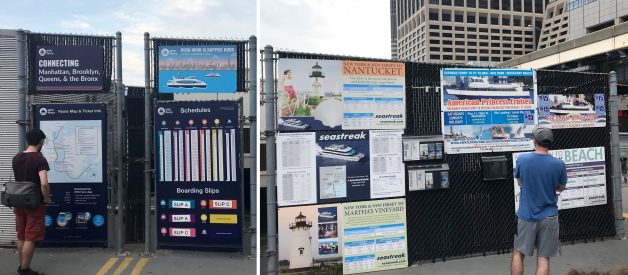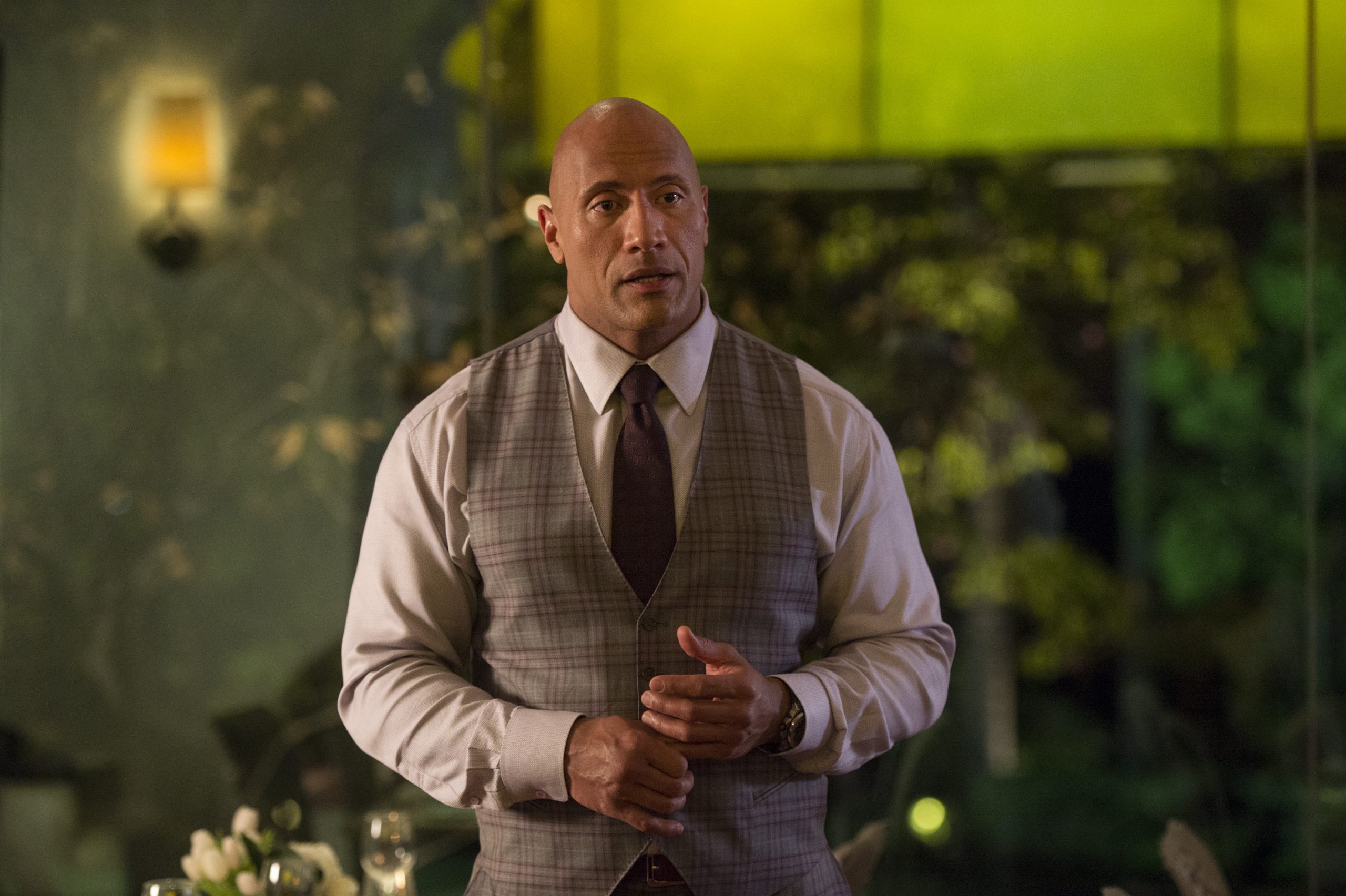New York Bay is is one of the largest natural harbors in the world. It has been crucial in the growth of the city has a commercial hub since its founding, and the Port of New York & New Jersey is still the busiest seaport on the East Coast.
While it?s important to point out that ferries alone will not replace the need for reliable and expanded rail infrastructure, they can play a role in making inaccessible parts of the region less so. Passenger ferry transportation flourished in the 19th Century once Robert Fulton?s Nassau ferry carried its first passengers between Brooklyn and Manhattan. But with the advent of bridges, subways, and cars, ferry ridership waned, with the chief exception of the Staten Island Ferry.
Recently, with interest from the City and its Economic Development Corporation (NYCEDC), ferry services on the East River have resumed under the banner of NYC Ferry, whose ridership has already exceeded the City’s expectations. It joins a range of ferry services that have slowly rebuilt maritime connections between the city’s boroughs, as well as Long Island, New Jersey, and even Massachusetts.
Current ferry operators in New York Harbor? NYC Department of Transportation operates the Staten Island Ferry. ? NYC Ferry connecting Manhattan, Brooklyn, Queens and the Bronx along the East River. ? The Trust for Governors Island runs free ferries from Manhattan and Brooklyn to the Island during the summer. ? Liberty Landing Ferry operates between Liberty State Park and Warren Street in Jersey City to the World Financial Center. ? New York Waterway runs a number of routes between New Jersey and Manhattan. ? NY Water Taxi operates between Pier 11 and the Ikea-Redhook, as well as hop-on-hop-off services. ? Seastreak operates service between the Rockaways and Manhattan, between Monmouth County and New York City, as well as seasonal services, including weekend service to Martha?s Vineyard and Nantucket. ? Statue Cruises operates ferry service to the Statue of Liberty National Monument and Ellis Island Immigration Museum.
All over the United States, public transit systems are seeing withering or declining ridership. While every city faces unique issues, a major reason for this across the board is that the rider?s experience hasn?t been fully considered?and if it were to be prioritized, riders? perception of the service would lead to a positive cycle of satisfaction and investment. This is something I?ve written about in this white paper.
The current experience of riding a ferry in New York is fragmented and disjointed, with a plethora of information available, but none of it presented consistently. This is seemingly because of the organic nature in which the ferry services have been developed-with multiple providers operating separate routes, fare structures, and destinations.
As such, ferry riders encounter an overwhelming scene like the one below, at Pier 11/Wall Street:
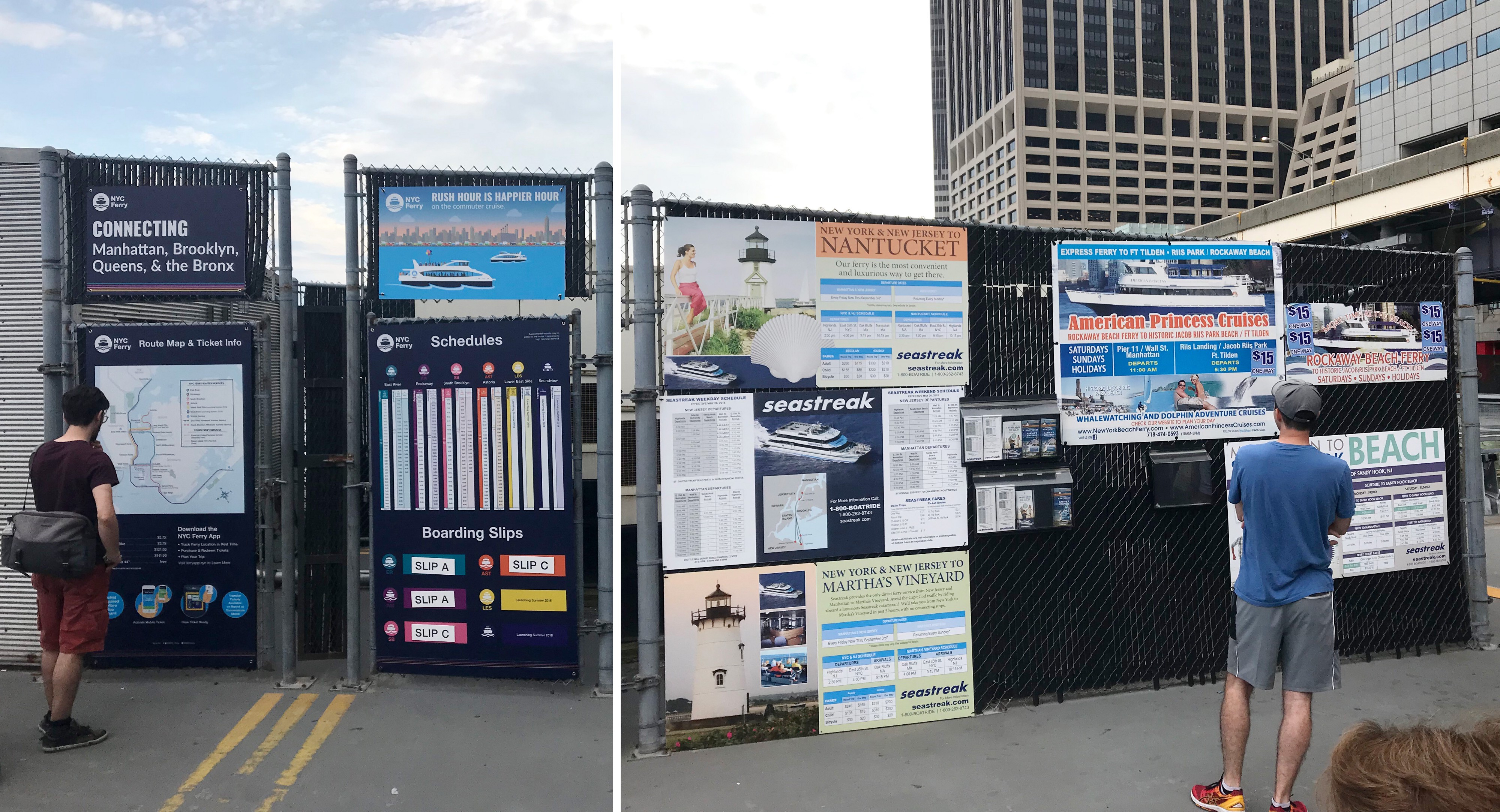 Various operators? passenger communications at Pier 11 / Wall St.
Various operators? passenger communications at Pier 11 / Wall St.
If a commuter arrived at Pier 11 wondering how to take the ferry to their home in Greenpoint, how long would it take them to find the information they needed using these signs? How many tourists give up on riding a ferry after seeing the jarring scene above? How many hours of staff time is wasted on explaining the above information, rather than operating the service?
I myself had a recent experience that piqued my interest in the need for better rider communications and called for an exploration into possible solutions. On a recent weekend evening, friends and I arrived in DUMBO hoping to visit Governors Island and its attractive waterfront bar. NYC Ferry employees emphatically told us there was no way to reach our destination, as their last ferry to the island-park had already departed, and that the only remaining ferries went to Manhattan. But I knew from past experience an alternative ferry service, run by the City?s Department of Transportation (NYCDOT), runs from the Battery Maritime Building, only a few minutes? walk from Pier 11 , where the DUMBO ferry would arrive. I took this route and enjoyed a lovely sunset. How many people every day miss out on travel opportunities to discover the region?
If more cohesive operational structures and rider-focused communications were developed for the currently disparate collection of ferry operators, the ferry experience would be poised to become an overarching system for water transportation across the entire region.
I considered what interventions would yield greatest improvements, and posit the following could improve the rider?s experience meaningfully. By prioritizing the rider?s experience, I think these solutions stand to benefit not only the riders, but also operators that could maximize each trip, as well as the region as a whole to bolster economic development, quality of life, and tourism.
- an integrated map of all ferry services;
- departure boards with integrated departures across companies;
- standardized presentation of promotional information, in particular for special cruises and trips;
- neighborhood maps showing walking distance to nearby ferry stops;
As a proof of concept, I started the design process for an integrated map.
New York Harbor Integrated Ferry Map, a Proposal
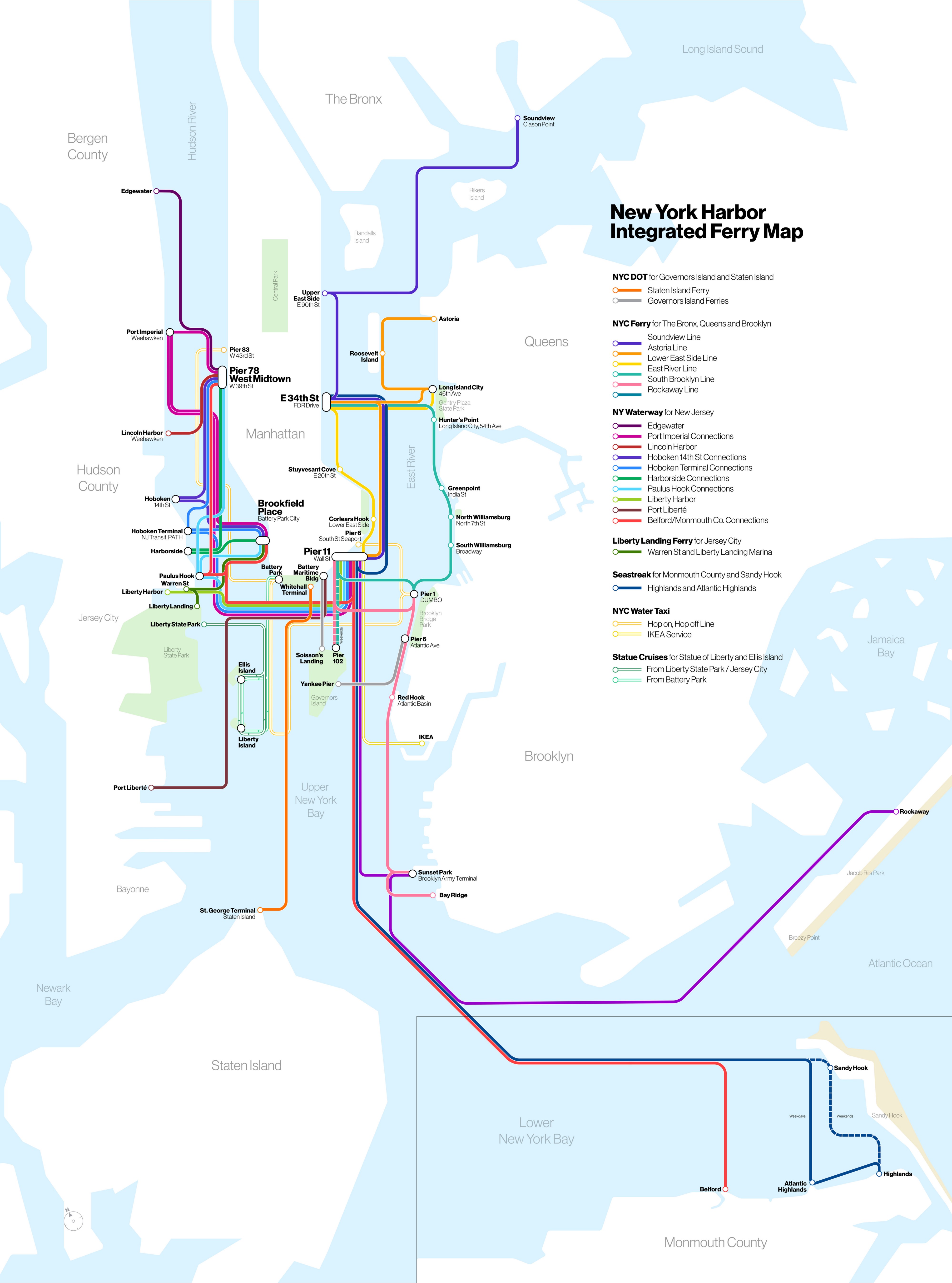 A proposal for a unified ferry map.
A proposal for a unified ferry map.
Audit
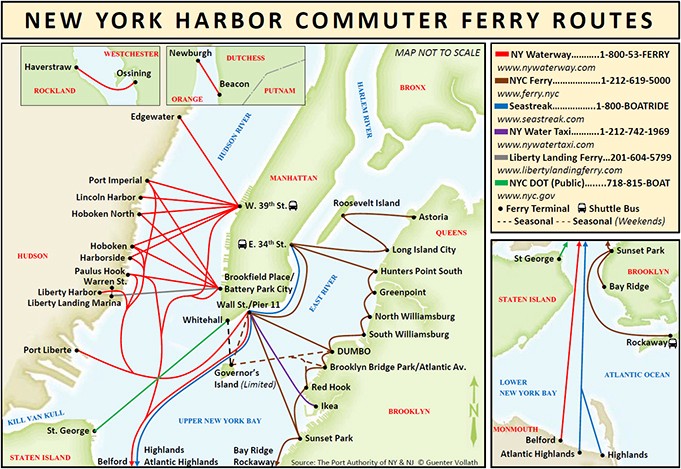 Source: PANYNJ
Source: PANYNJ
An audit of all services proved to be an interesting process, since such a map had never been attempted, to our knowledge. The closest one available is from the Port Authority of New York & New Jersey. It is a high-level presentation of commuter connections, but omits quite a few services.
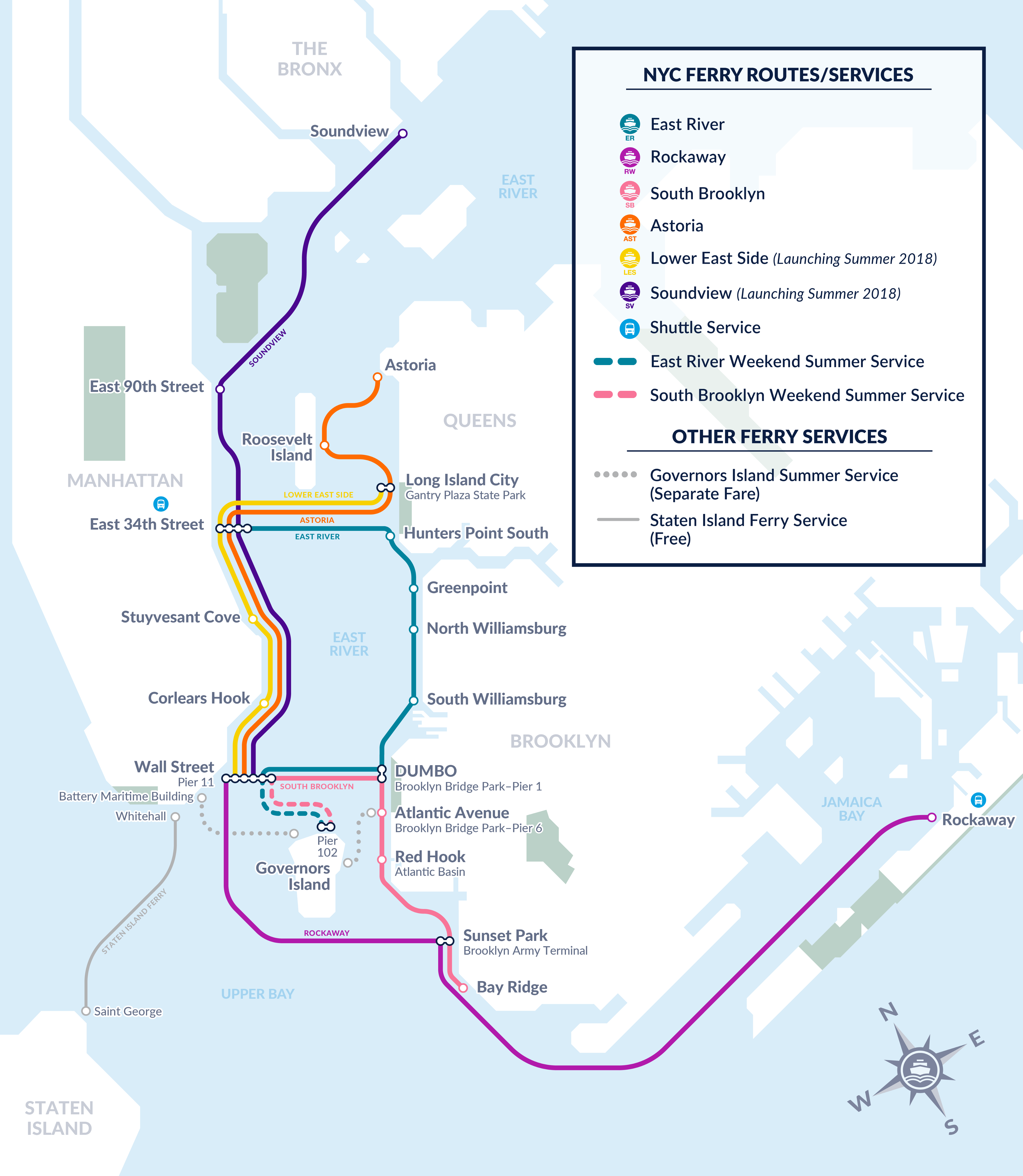 Source: NYC Ferry
Source: NYC Ferry
NYC Ferry, as the most recent service to be introduced, is graced by an attractive map with color coded lines that doesn?t have to bear the burden of too many lines.
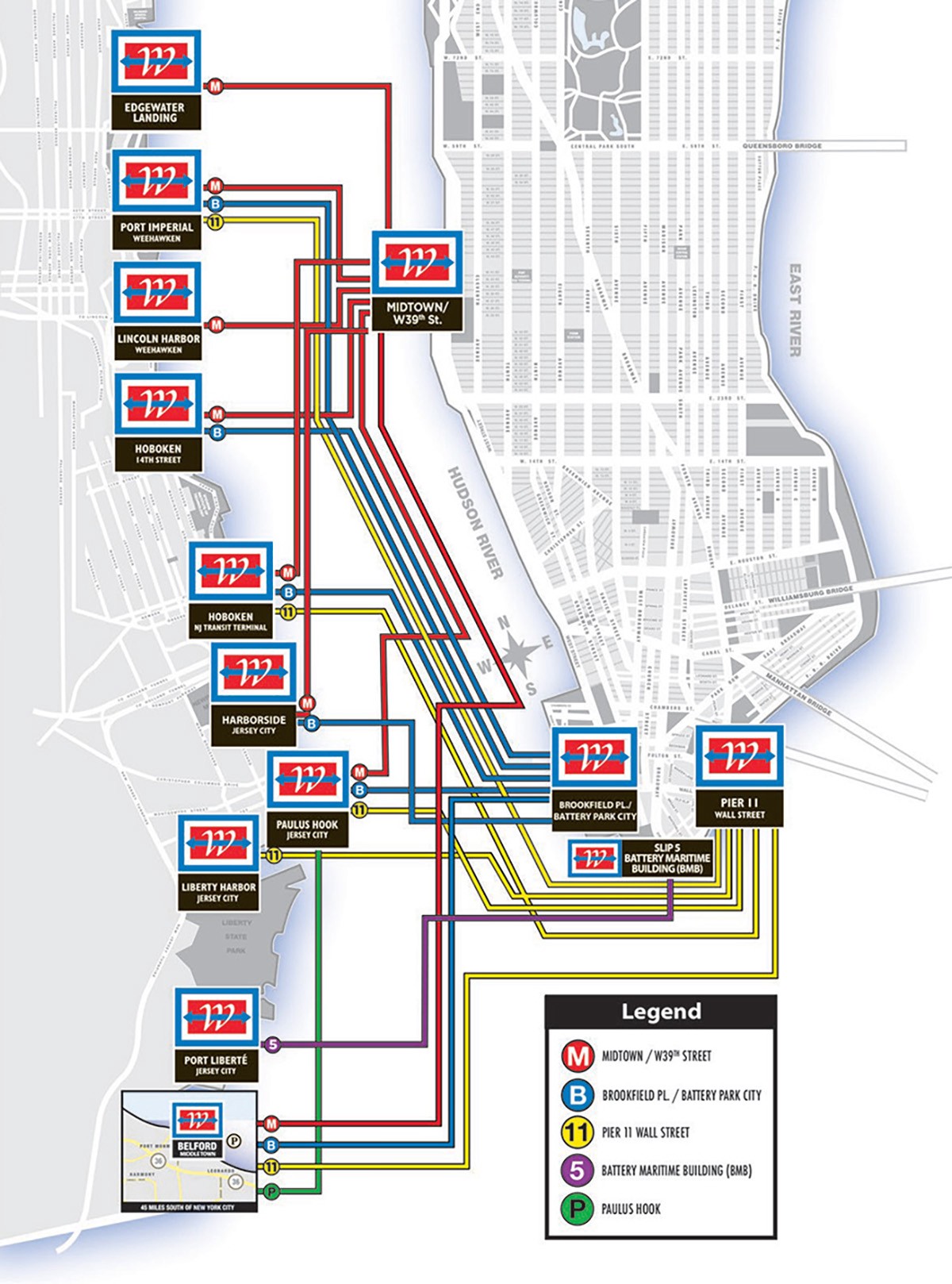 Source: NY Waterway
Source: NY Waterway
NY Waterway has a more diagrammatic approach, where lines are color-coded to their respective Manhattan termini: Yellow for Wall Street, Red for Midtown, Blue for Battery Park City. It ends up being more useful as an overview of departure points, rather than a follow-the-lines diagram.
Touristic lines, like Statue Cruises which is the only way to visit the Statue of Liberty and Ellis Island, and the NYC Water Taxi, are quite simple diagrams.
Process
Once we add all services and landing slips to our regional map, we see a robust service that is begging for a map.
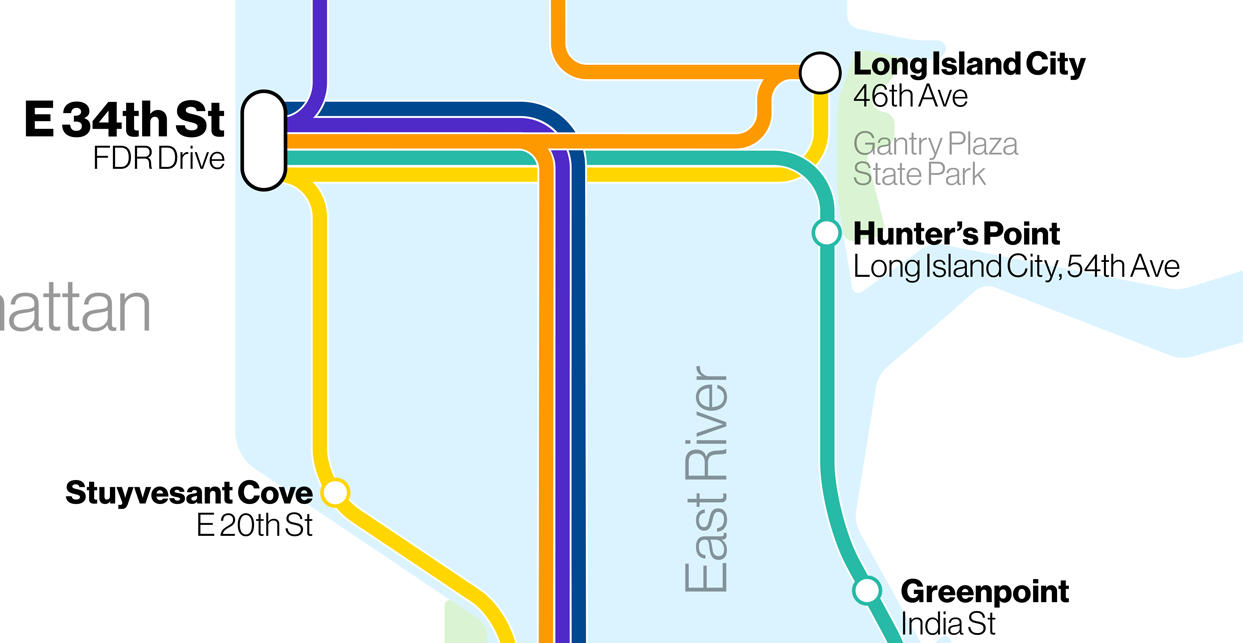 Black dot, all line stops; Color dot, only one line stops.
Black dot, all line stops; Color dot, only one line stops.
The next step was to define the map?s treatment of lines and stations. One of the inherent challenge is that while many lines are simple nonstop trips, all of NYC Ferry services involves multiple stops along a route, more akin to a subway route than a traditional ferry shuttle service. I opted for a trunk-based treatment (with apologies to Massimo Vignelli?s iconic NYC Subway map), showing multi-line/transfer stations using a black outlined receptor shape.
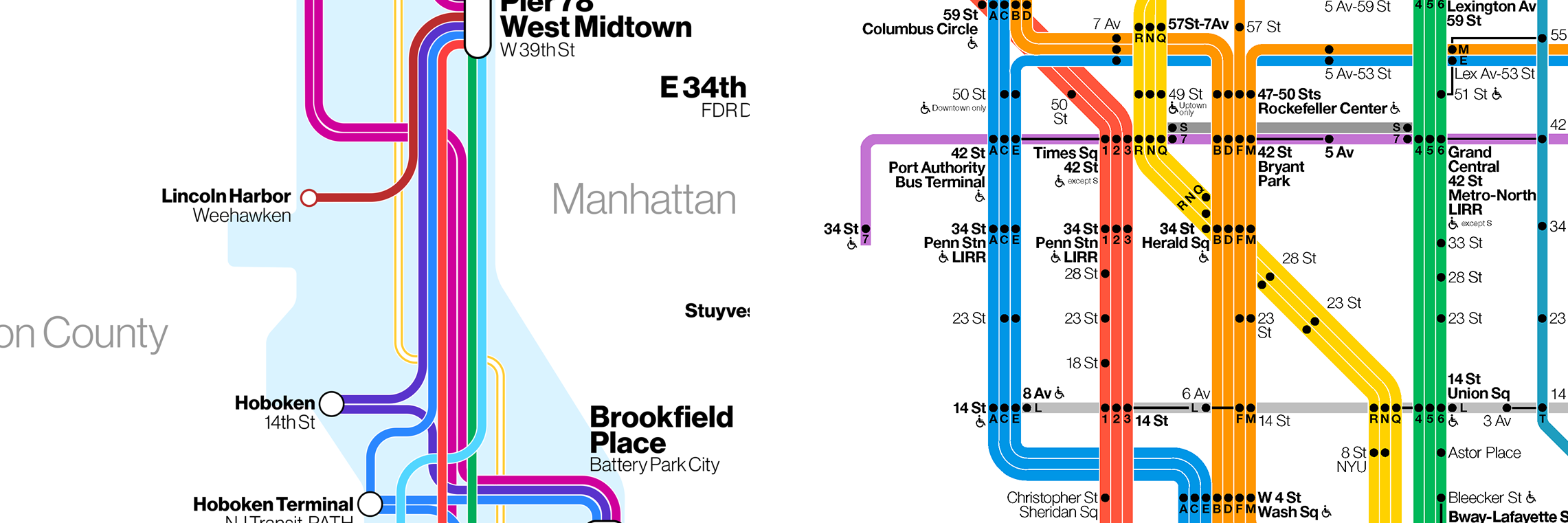 Trunk lines FTW: Ferry Map left, Updated Vignelli Map right.
Trunk lines FTW: Ferry Map left, Updated Vignelli Map right.
The Hudson River services prove to be choppier waters, with many New Jersey origin points to three main destinations in Manhattan: Midtown, Battery Park City, and Pier 11. I opted to turn the current NY Waterway convention on its head by color coding based on Jersey-side origination points, since maintaining the three-color scheme in a non-diagrammatic context was graphically pointless.
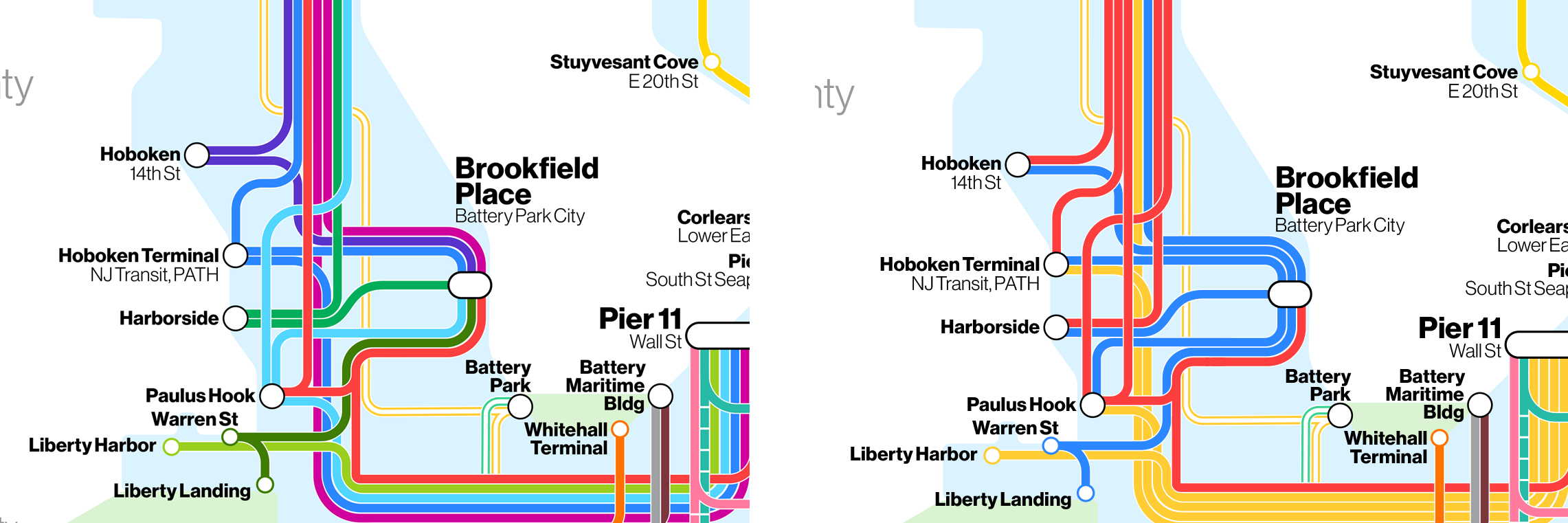 Our proposed color scheme compared to NY Waterway?s original construct.
Our proposed color scheme compared to NY Waterway?s original construct.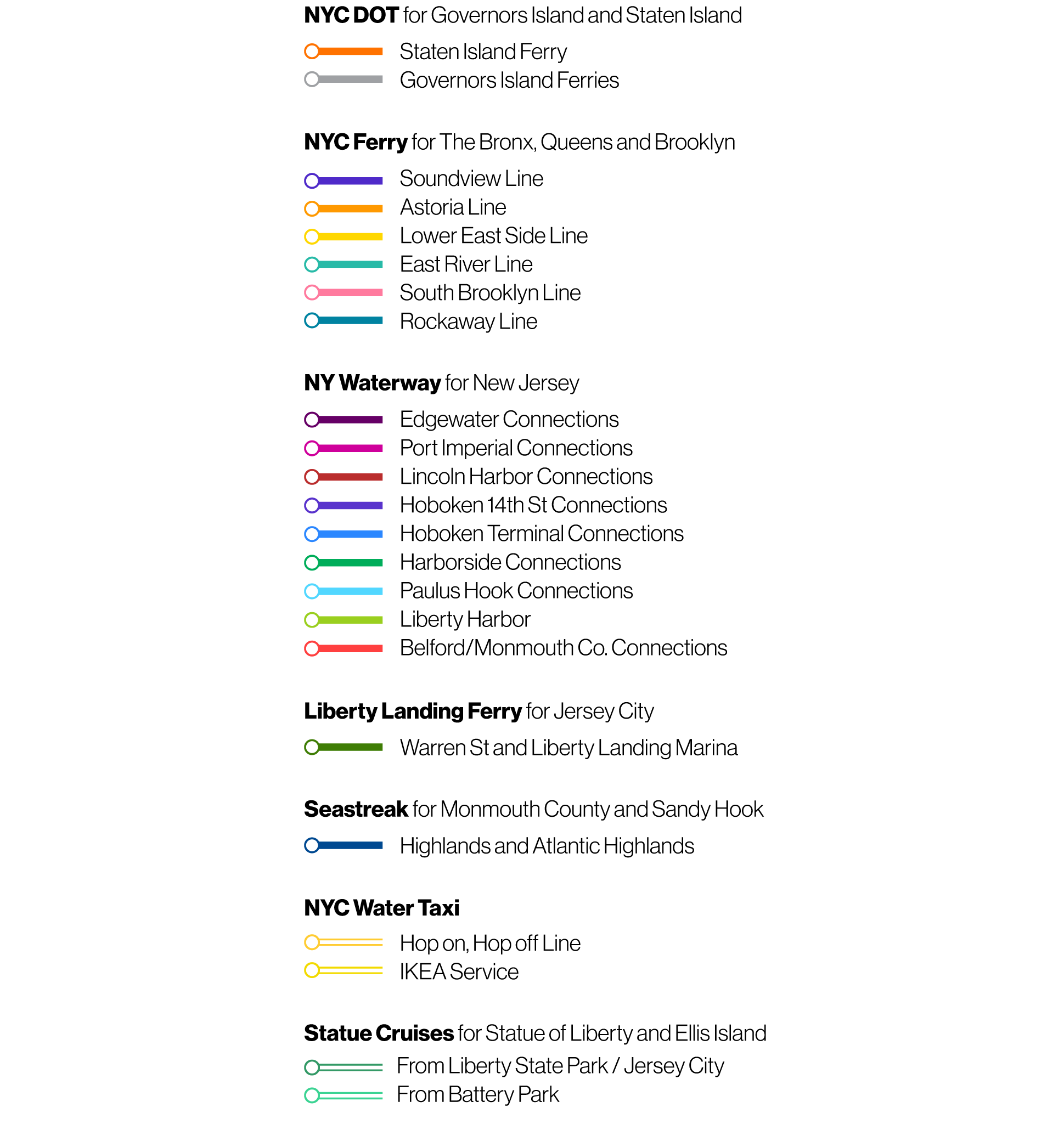
The sheer amount of services proves a challenge in determining a sufficiently distanced color coding. I kept the original scheme from NYC Ferry, which aids rider legibility for oncoming boats.
Finally, I introduce a distinction for touristic services, using an outline for those.
Further Proposals
Turning the ferry into a viable alternative to trains, buses and cars will require many things, most importantly scale. Already many of NYC Ferry?s 400-passengers ships have to turn down would-be riders. But specific enhancements could go a long way in successfully rounding out the regions? transit alternatives.
Harmonize schedules between ferry operators and transit agencies
Could someone who lives in Jersey City go to work in Greenpoint by water, or vice versa? By making sure the NY Waterway schedule aligns with NYC Ferry?s East River line, it?d be possible. Especially in transit-rich ferry terminals, such as Hoboken Terminal, having alignment to bus and rail service enables the ferries to be a useful complement to the region?s transit diet. NY Waterway has started this process with its Hudson Go Pass collaboration with NJ Transit, but many services still operate their own bus transfers system, rather than cooperating with existing providers.
Rethink the terminal experience
It?s currently quite confusing to conduct a transfer, and while efforts such as kiosks and departure boards at some terminals help a bit, much improved signage could facilitate the kinds of transfers suggested above. This is the kind of effort that requires rider-centric approach to design, and optimizes for the realities of a relatively hectic and busy environment by offering the right information at the right place and time. A screen while people wait to alight the ship could indicate upcoming connections with a diagram of the berths where they can be boarded, as is done on trains in Switzerland.
New MTA fare payment opportunity to enable and simplify transfers
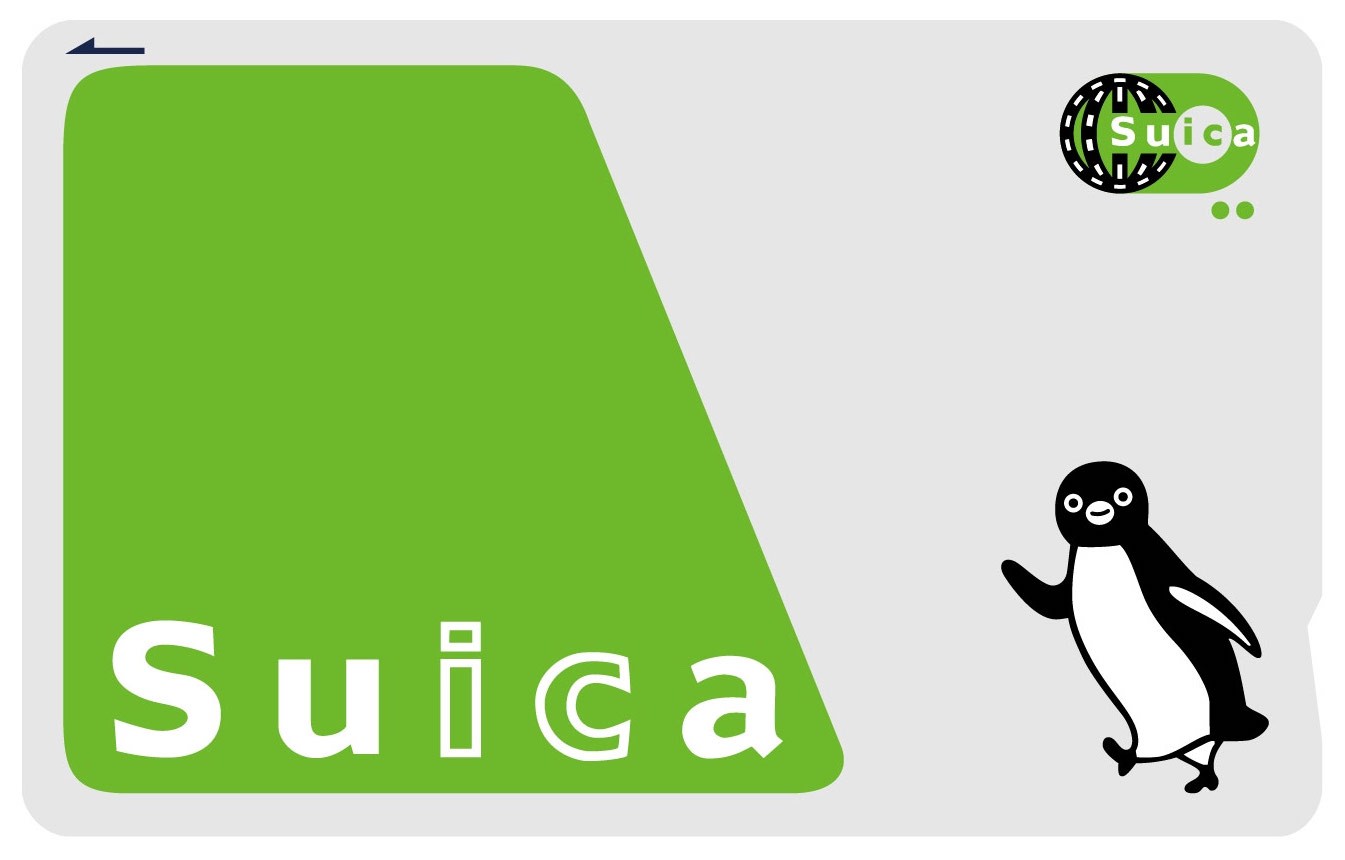 JR East? Suica card allows people to pay for transportation across the Tokyo region, and also at shops like cafs and restaurants.
JR East? Suica card allows people to pay for transportation across the Tokyo region, and also at shops like cafs and restaurants.
The Seastreak vessels leave 34th Street for Monmouth County and stop at Pier 11 on their way. Couldn?t excess capacity be sold for the same fare as NYC Ferry?s Astoria line, which does the exact same trajectory? A new fare payment system to be introduced by the MTA next year would make this, and countless other journeys, feasible, lowering the complexity of using the waterways.
Final Thoughts
This is a work in progress, and indeed a first step, but I think it shows the potential of ways to harmonize a disparate collection of services into a cohesive experience.
